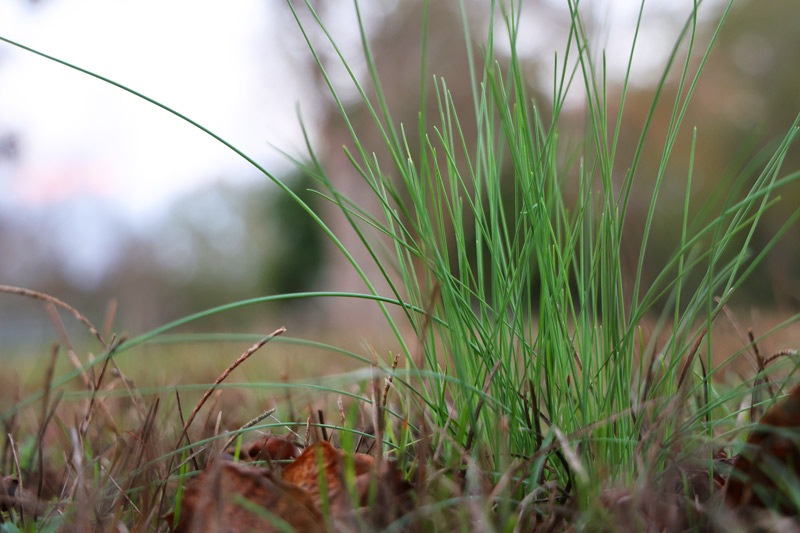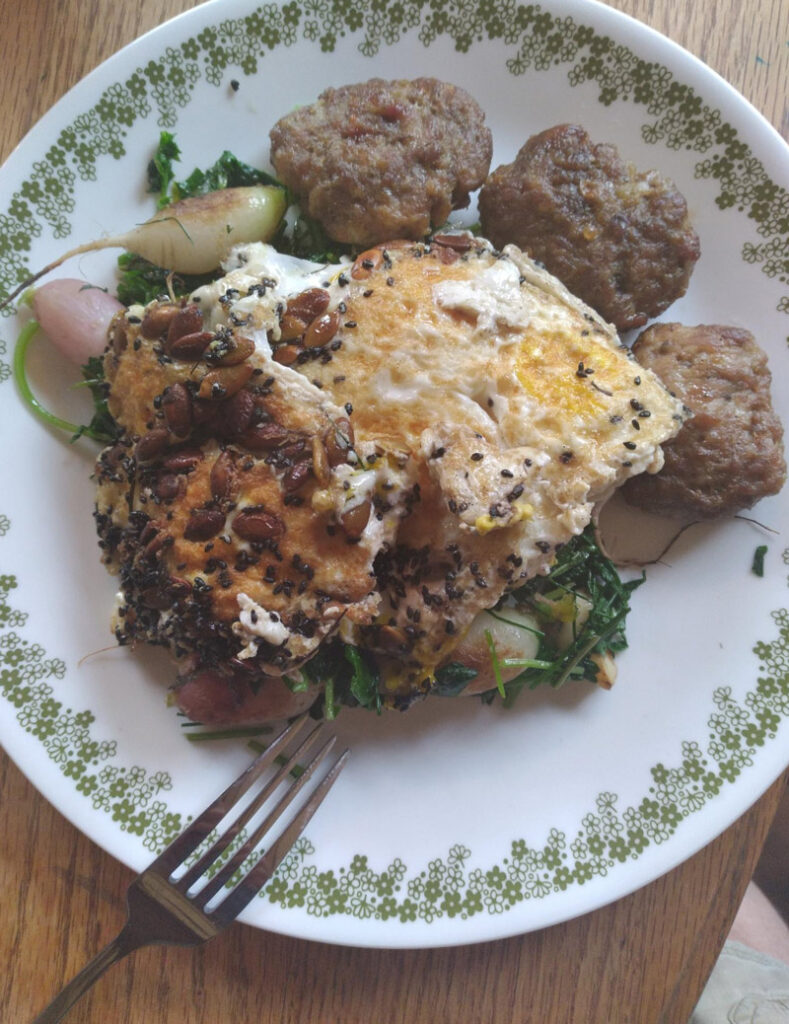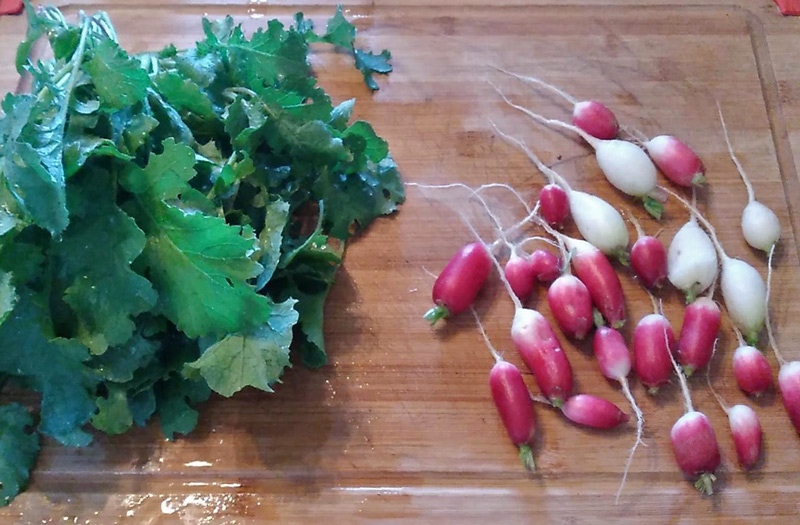On Wednesday I wrote about a few of the wild greens you can forage in the South at this time of year.
But what do you do with them once you’ve foraged for them?
If you’ve ever tasted wild dandelion greens, you might have found the bitterness shocking. Aren’t they supposed to be an amazing wild green?
As Dr. John Kallas writes in Backwoods Home:
“We’ve heard stories about how good dandelions are. What one usually hears from enthusiastic wild food promoters is, “All you need to do is find very young dandelion leaves in the early spring, before the flower stalks appear. If you do this they won’t be bitter. They’ll be the most delicious and nutritious fresh greens you will ever eat.”
Well my friends, that was not reflected in my early or continuing experiences with the plant. Was I doing something wrong? Why is it that you hear and read such good things about a plant that, even in its youth, is often excruciatingly bitter?”
That’s been our experience as well. However, we don’t eat our wild greens raw, except for the occasional nibble while gathering. Our preparation is different, as I’ll share in a moment.
As Kallas continues:
“While working on my Ph.D. about 20 year ago, I designed a survey-driven research project of senior citizens in a rural Michigan farming community. Many of these people were born between 1890 and 1910. Most had grown up in an era where there was no electricity, no cars, no supermarkets. They lived off canned, bagged, and bottled food they bought from the general store, whatever agricultural food they could produce or trade for, and wild foods they gathered from the surrounding area. The wild foods helped to spice up and add diversity to their diets. Dandelions were one of the most commonly eaten foods.
When I asked these people if they experienced dandelions and dandelion salads to be bitter, almost everyone interviewed said no, dandelions were not bitter. I was wondering what planet I was visiting. Had all these farmers been replaced by alien pod people? What was I missing here? At some point, I began asking, “How did you prepare your salad?” This is what they told me: “You take a big mess of fresh dandelion greens, you cook up some bacon, you pour the hot grease over the dandelions, you chop up the bacon and sprinkle that over the greens, you cook up a couple of hard boiled eggs, chop them up and disperse them over the greens, you add salt and occasionally vinegar, and there you have itdandelion salad (also known as wilted greens).
The gears in my brain now had something to work with. It was becoming more and more clear to me that anytime experienced dandelion eaters discussed flavor, it was within the context of how it was served, not the fresh plant straight from the ground. Hardly anyone actually eats dandelions that way.”
So how do we eat dandelions and other wild greens?
Wild Greens for Breakfast
Our favorite way to consume them is for breakfast, sautéed in a good fat. Real lard, virgin coconut oil, beef tallow or ghee are good for this. Saturated fat is awesome for cooking. Occasionally we’ll also use sesame oil, since it adds a delightful nuttiness.
We pick and wash our greens, then heat up oil in a cast iron pan, then toss them in and stir them until they’re well-wilted. After they’re done, we add farm eggs, either just cooking them over-easy, right into the greens, or scrambling them through. Sometimes we’ll cook bacon, sausage, or another meat before the greens, then use the fat left behind to sauté with. Other times we’ll throw in sesame seeds, pumpkin seeds or peanuts and splash in some soy sauce.
Herbs from the garden are also welcome, including chives, green onions, sage, rosemary, oregano, thyme, parsley, cilantro, and basil. If we have moringa leaves, we add them too. During the winter and spring, we also throw in wild onions from the yard.

This was yesterday’s breakfast:

The eggs are on top of a bed of wild greens mixed with radishes and radish greens from our gardens.

Rachel fried the radishes whole. Cooking them takes out some of the sharp flavors, as it also does with wild greens.
Once dandelions and other greens are sautéed in a good fat, their flavor is greatly improved.
Here’s today’s breakfast:

The greens there are a mix of pak choi from the garden, with a few radishes and a generous helping of henbit from the Grocery Row Gardens where it’s happily taken over. Henbit doesn’t have the best texture when raw, but when sautéed it’s quite decent.
Wild Greens In Other Things
Another good way to consume wild greens is in soups. They can be chopped and added to just about any soup, where they meld into the overall flavor while adding extra nutrition and goodness.
A really good soup base for the cold time of year can be made from grated ginger, garlic crushed through a press or finely chopped, a generous helping of wild onion greens and a good bit of sea salt. This is a great broth. One of my favorite soups is to make a few cups of this broth, then stir it rapidly as it boils and break in a few eggs and a good pinch of crushed red pepper. That’s both healthy and filling, especially when you have a cold.
Wild greens can easily be mixed into salads in small amounts, cooked into lasagnas, chopped and added to spaghetti or pizza sauce or blended into a smoothie.
We eat a mostly whole food, borderline keto diet with little bread and no pasta, so most of our green consumption is in our breakfast eggs and in soups, but you can be creative with whatever you’re cooking.
As Jo Robinson states in an interview:
“My intuition was that wild plants were more nutritious than the plant food we eat today, but I wasn’t prepared for the extent of those differences. Some wild tomatoes, for example, have 30 times more of a heart-protective compound called lycopene than our supermarket tomatoes. The wild dandelions in our lawns have eight times more antioxidants than spinach, which we regard as a superfood. Unwittingly, we have bred a wealth of nutrients out of the human diet.” (You can check out Robinson’s book here.)
Eating on the wild side really does seem to be beneficial, plus it saves us some shopping. Why buy greens when we can forage healthier ones for free?


8 comments
Thank you for this. Gives me lots of food for thought and ideas of how to incorporate these things into my family’s diet. I’m new to growing things and often I am overwhelmed with how much I still need to learn. This post was so practical in providing a vision of how to use what the Lord has already provided and we have overlooked. Keep ‘em coming, David, you have been such a blessing to me!
Huh. The dandelions we picked just for snacking weren’t bitter and it was later in spring after they’d bloomed. Still, bacon grease does make everything better.
Maybe you have sweeter dandelions up there.
Excellent post! I’ve used all of your ideas, and more. My grown, in-their-forties daughters to this day still sometimes tease about how ‘Mom made us eat weeds!’ I figured, well, most of the weeds growing in our garden were edible, so why not eat them?
My grandma used to say we’d have to eat worms if we didn’t like dinner. It’s close!
They are also less bitter when they first sprout, before they’ve put up any flower buds. Ditto after a nip of frost.
I’ve got a couple of semi-domesticated chicory plants in pots (*&%$ rental house), waiting for a permanent garden home. I like to pinch a small leaf off and eat it raw now and then– in small quantities the bitterness feels refreshing and medicinal, rather than unpleasant.
I discovered by accident that blanching the dandelion (the horticultural way, not the culinary way) also really helps with the bitterness. I had covered over a poorly-placed dandelion with the saucer from a flower pot to try and smother it without disturbing other plants around it. When I checked the progress of the die-off, I tried a few nibbles and found a taste similar to iceberg lettuce.
Blanched dandelions sounds like high cuisine!
Comments are closed.